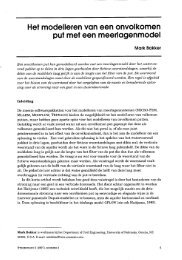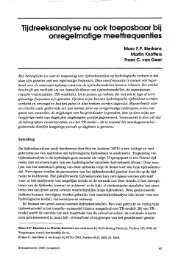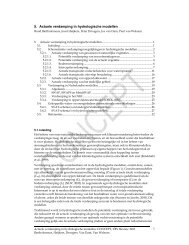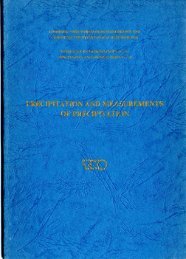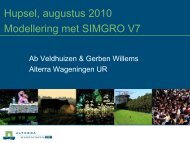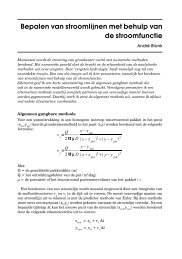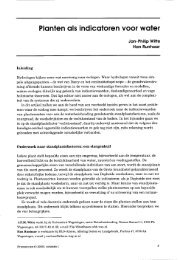Hydro-ecological relations in the Delta Waters
Hydro-ecological relations in the Delta Waters
Hydro-ecological relations in the Delta Waters
Create successful ePaper yourself
Turn your PDF publications into a flip-book with our unique Google optimized e-Paper software.
Bio-essay Weriments with polluted sediment from Due of <strong>the</strong> smaller<br />
harbours <strong>in</strong> <strong>the</strong> <strong>Delta</strong> region (&resicens) revealed effects on oyster<br />
larvae (Crassostrea Awulatal and a ernstacean Lhthypreia).<br />
Even when B large proportion of Clew sediment was added to <strong>the</strong><br />
polluted harbour sludge, mortality rates were demonstrably affected by<br />
pollution (Hnrk, 19883.<br />
The effects of <strong>in</strong>creas<strong>in</strong>g pollution <strong>in</strong> water md riverbeds are al-so<br />
noticeable <strong>in</strong> <strong>the</strong> Western Srheldt estuary. The popuLation of hatbaur<br />
seals (Phoca vitul<strong>in</strong>a) has now disappeared. Food cha<strong>in</strong>s <strong>in</strong> rhe eastern<br />
part of <strong>the</strong> estuary have been dfs<strong>the</strong>d and <strong>the</strong> number of benthic<br />
organisms significaatly raduced. It is acknowledged that <strong>the</strong> amounts of<br />
cabmiwu now exceed acceptable leveLs for hum consumption.<br />
particularly <strong>in</strong> flounder (Platickthys flesus), <strong>in</strong> shellfish such as<br />
mussels (Mytilus edule) aad <strong>in</strong> sea plants such as Aster tripolium and<br />
Salicornfa spec., foutld <strong>in</strong> <strong>the</strong> Lad of Saeft<strong>in</strong>ghe area.<br />
6 CONCLXISIONS AI43 FINAL ReMaaKS<br />
Although water quality and <strong>the</strong> condition of <strong>the</strong> beds we*e not taken<br />
<strong>in</strong>tn consideration at <strong>the</strong> time of <strong>the</strong> origtnal decisions concern<strong>in</strong>g <strong>the</strong><br />
phas<strong>in</strong>g and implementation 05 <strong>the</strong> <strong>Delta</strong> Plan, it is now recognized that<br />
<strong>the</strong> separation of parts of <strong>the</strong> <strong>Delta</strong> from <strong>the</strong> waters of <strong>the</strong> Rh<strong>in</strong>e and<br />
Eeuse, as part of <strong>the</strong> compartmentalization programme for <strong>the</strong> regiwn,<br />
has played a significant role <strong>in</strong> wtnta<strong>in</strong>Ss& a satisfactory level of<br />
quality <strong>in</strong> <strong>the</strong> majority of <strong>the</strong> beds <strong>in</strong> <strong>the</strong> <strong>Delta</strong>. As a result, <strong>the</strong><br />
quality of <strong>the</strong> sediment <strong>in</strong> tlle central secrion of <strong>the</strong> estuary is clese<br />
to natural backgrrrwd levelS. However, <strong>the</strong> closure of an estuary such<br />
as <strong>the</strong> Rar<strong>in</strong>8vliet ean lead to large amounts of polluted river ~ilt<br />
settl<strong>in</strong>g <strong>in</strong> new sedimentation areas. An o<strong>the</strong>r ntethod af controll<strong>in</strong>g<br />
<strong>the</strong> distribution of contam<strong>in</strong>ated rmaterial is to limit <strong>the</strong> tkrou~hpm of<br />
water if sluices for water management are available <strong>in</strong> <strong>the</strong><br />
colnpartment~llzation-dams. This idea has, for <strong>in</strong>stance, been<br />
<strong>in</strong>corporated <strong>in</strong>to <strong>the</strong> plan for manag<strong>in</strong>g <strong>the</strong> quanrity of water of Lake<br />
Zao<strong>in</strong>.





